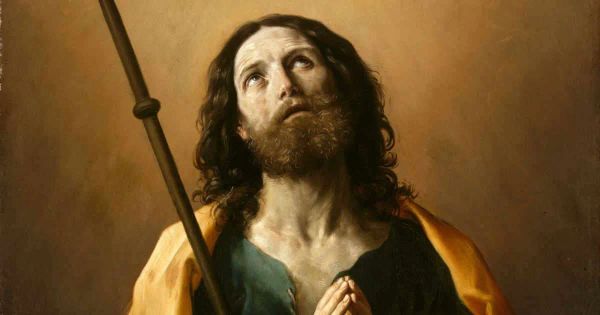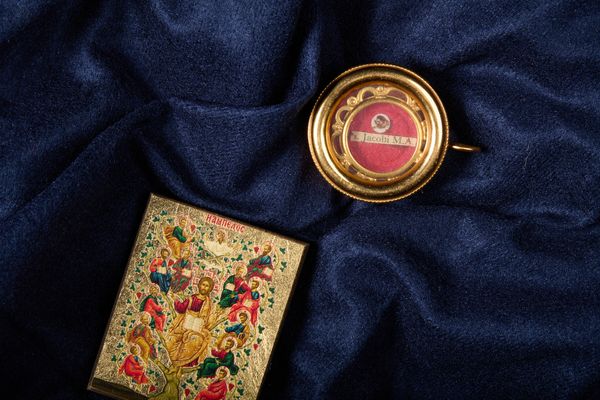Among the Twelve Apostles were two named James: James, the son of Zebedee and James, the son of Alpheus. The former is traditionally called James the Greater, and the latter is traditionally called James the Lesser, perhaps because the former was taller than the latter, or more likely because of the greater importance James the Greater played in the Gospel narrative.
James the Greater, whom we honor today, was the brother of John, the Gospel writer. Their mother is traditionally believed to be Salome, who is identified as the sister to the Blessed Virgin Mary. Hence, if Salome and Mary were siblings, then James and John were Jesus’ cousins.
In John’s Gospel, two of John the Baptist’s disciples were with John when he saw Jesus walking by. The Baptist said of Jesus, “Behold, the Lamb of God.” The two disciples then left the Baptist and followed Jesus. One of the disciples was Andrew, and the other is traditionally believed to be James the Greater. The Gospels of Matthew and Mark record James’ calling a bit differently. “Jesus walked along a little farther and saw James, the son of Zebedee, and his brother John. They too were in a boat mending their nets. Then he called them. So they left their father Zebedee in the boat along with the hired men and followed him”. James and John most likely came from a family of means. Their father, Zebedee, most likely employed other fishermen alongside his sons. Their mother, Salome, is said to have been one of the women who supported Jesus and the disciples out of her own means. And John was entrusted with the care of Jesus’ mother, partly implying that he had the means to do so.
Among the Twelve Apostles, Peter, James, and John are recorded in the Gospels as being present at three special events that the others were not. First, when Jesus cured Jairus’ daughter, Jesus brought these three into the house with Him. Second, it was only these three whom Jesus took with Him when He was transfigured in glory on top of a high mountain. Finally, these three alone accompanied Jesus after the Last Supper during Jesus’ Agony in the Garden. Though they fell asleep three times during our Lord’s agony, they were, nonetheless, privileged to be there with Him.
In Luke, Jesus “resolutely determined to journey to Jerusalem” where He knew He would suffer death. On His journey toward Jerusalem, Jesus sent disciples ahead of Him to a Samaritan town to prepare for his arrival. However, the Samaritans would not welcome Jesus and His disciples. As a result, James and John ask Jesus, “Lord, do you want us to call down fire from heaven to consume them?” Jesus rebuked them for this thought and they traveled on. It was on account of this excessive zeal and perhaps the quick tempers and boldness of James and John that they are referred to as the “Sons of Thunder”.
One last mention of James is found in Acts. Herod Agrippa, who ruled Judea from 41–44, martyred James the Greater as a way of appeasing the Pharisaic Jews who were opposed to Jesus and His followers. According to an account by Eusebius, a fourth-century Bishop of Caesarea Maritima, James’ zeal for the faith led to his arrest, but the one who turned James in as his accuser ended up converting to the faith. As a result, his accuser was also martyred with James.
One later tradition states that James traveled to Spain to preach the Gospel before returning to Jerusalem to endure martyrdom. That same tradition states that after his martyrdom, his body was either miraculously transported to Spain, eventually arriving in Compostela where many believe he is buried, or that his body was taken to Spain by his followers. The exact site of his burial was lost for centuries. In the ninth century, a hermit named Pelagius observed a star or a cluster of stars that led him to Saint James’ burial site in Compostela. After the discovery, King Alfonso II ordered the construction of a church over his grave; the site is now referred to as Santiago (Saint James) of Compostela (field of stars). Since that time, the site has been a major pilgrimage site. The Camino de Santiago (Way of Saint James) is a route traveled on foot from various starting points in France, Spain, and Portugal that all lead to the Cathedral of Santiago de Compostela where Saint James is believed to have been buried. The longest route begins on the French side of the Pyrenees and stretches almost 500 miles. Other routes are shorter than 100 miles.
Credits:
Discriptions of saints lives and biographies have been excerpted, summarized, or compiled from
Franciscan Media,
CatholicSaints.Info,
Catholic Online, and
Wikipedia.


